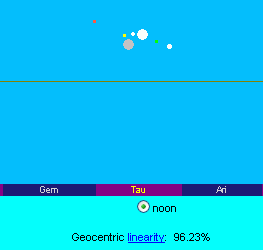The dates of birth and crucifixion of Jesus Christ
based on accurate astronomical computations
When was Jesus born?
The Catholic Encyclopedia gives a brief historical analysis and concludes that Jesus was most probably born in one of the years A.U.C. 747, 748 or 749, which is 7, 6, or 5 BC (A.U.C. = Ab Urbe Condita, i.e. from the foundation of the city, which is Rome, founded 753 BC). It also mentions a remarkable astronomical conjunction of Mars, Jupiter, and Saturn in Pisces, in the spring of A.U.C. 748, which could have been the star of Bethlehem. I think this refers to the event in the left picture below:
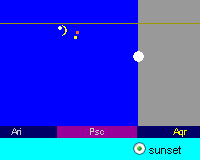 The western evening sky of Saturday, 20 Februari, 6 BC. Jupiter, the young Moon, Saturn, and Mars (red) in Pisces. But this is not in spring... |
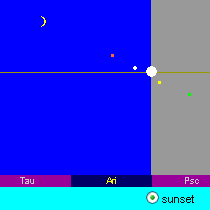 This is the situation when spring began on Tuesday 23 March 6 BC. Only Mars' elongation might be enough to be visible. |
But there was another remarkable astronomical event one year earlier, which was a triple true astronomical conjunction of Jupiter and Saturn, also in Pisces, during 7 BC (astronomical year -6), which is AUC 747 (AUC = astronomical year + 753). You can use the planetarium on my Astronomical Computations website to check this (the images on this page have been made with it; you'll have to notice that it uses astronomical year numbering, which includes the year zero, so 1 BC = 0, 2 BC = -1, 7 BC = -6 etc.). The conjunctions took place on the following dates, but of course some days before and after these conjunction dates both planets were also very close to each other in the sky (about half the width of a fingertip when pointing to them with a stretched arm):
- Friday the 29th of May, visible before sunrise, i.e. in the East, and it was new moon:
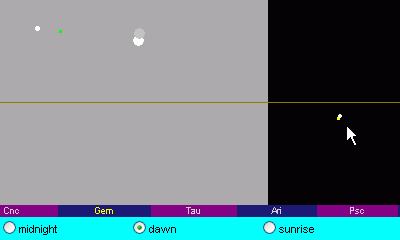 First conjunction of Jupiter and Saturn in the sign of Pisces in the morning sky of Friday 29 May, 7 BC. |
- Thursday, the 1st of October, visible all night, so going from East via South to West during the night, the moon phase was just over first quarter, and moreover, just after sunset ALL planets would have been visible in the sky:
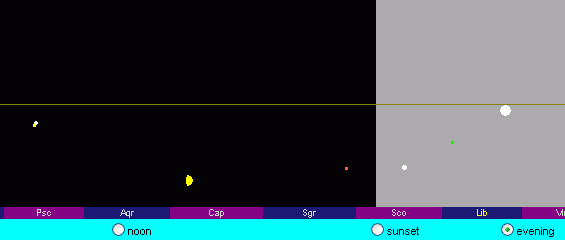 Second conjunction of Jupiter and Saturn in Pisces around midnight on Thursday 1 October, 7 BC. |
- Saturday, the 5th of December, visible after sunset, so in the West, and it was nearly full moon:
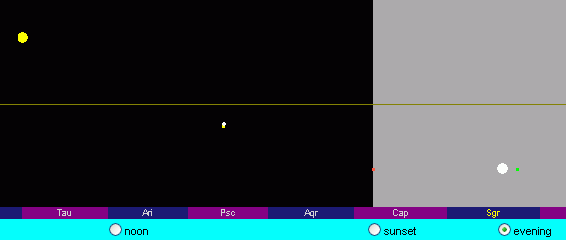 Third conjunction of Jupiter and Saturn in Pisces in the evening of Saturday 5 December, 7 BC. |
|
Intermezzo As you can see, the first conjunction took place in the East, during dawn, in the early morning sky before sunrise. The second was visible all night, rising early in the evening in the East, and setting in the West at dawn. The third conjunction was visible in the West during the evening. Altogether this is a very clear East-to-West movement of what could have been the star of Bethlehem. Could it have guided the Three Kings from the East to the West? But... Does: "they saw the star in the East" mean: "the star was in the East and they saw it" or: "they were in the East and they saw the star"? I've learned (but I am not sure) this ambiguity also exists in Aramese, Hebrew, and Greek, the ancient Biblical languages... |
|
Intermezzo Please notice that these three conjunctions took place in the sign of Pisces. The vernal equinox point (the position between the stars where the sun seems to be when spring begins) shifts approximately 1 zodiac sign every 2000 years, a phenomenon called precession. In ancient times people thought this period was exactly 2000 years, in reality it is approximately 26000/12 = 2167 years. Around the time Jesus was born, the vernal equinox was shifting from Aries to Pisces. The Pisces era was beginning and this conjunction, the presumed star of Bethlehem, occurred in Pisces. According to Sepp Rothwangl, author of the CALENdeRsign website, Pisces (meaning fish) is ICHTHYS in (Latinised) Greek, which would be an acrostic for Iesous CHristos Theou HYios Soter (Jesus Christ, Son of God, Saviour). Nowadays the vernal equinox point is shifting towards the sign of Aquarius (maybe you remember the musical Hair (1967) with a song called Aquarius, where they sing: "This is the dawning of the age of Aquarius"). |
Two months before the first of these three conjunctions another phenomenon occurred in the early morning of Saturday (Sabbath) the 28th of March in 7 BC, which must have been visible shortly before sunrise. On this date, Jupiter and Saturn both were already near to each other in the constellation of Pisces, but Mercury and the Moon were also quite near them in Pisces, visible in the Eastern morning sky. The moon was a waning crescent, two and a half days before the astronomical new moon on 30 March in the evening, and Mercury was still very close to its greatest western elongation, which occurred ca. 2 weeks earlier:
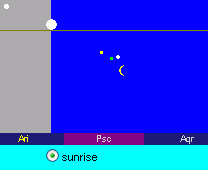
The early morning sky of Saturday 28 March, 7 BC.
In Pisces, from left to right: Saturn, Mercury, Jupiter, Moon.
However, this date of 28 March is not exactly correct, because it has been computed backward using Julian calendar arithmetic that does not take the following into account. When, in 45 BC, Julius Caesar had introduced his calender with a leap day every four years, the Romans made one stupid mistake. They started counting years from I to IV, applied a leap day, and then counted this very same year number IV also as number I of the next leap cycle, effectively inserting a leap day every THREE years. This mistake was discovered during the reign of emperor Augustus, who then skipped some leap days to correct this flaw. In Claus Tøndering's Calendar FAQ you can find that the following years were leap years: from 45 BC through 9 BC every 3 years, then 3 leap days were not applied (in 5 BC, 1 BC, and AD 4), and from AD 8 onwards every 4th year was a leap year until AD 1700, when the Gregorian calendar skipped a leap day for the first time. This implies that in 7 BC, 3 days must be subtracted from each computed date without changing the weekday. For the precise dates of the 3 conjunctions this is not so relevant, but for this last phenomenon I do apply this correction, so what has been computed as Saturday 28 March actually was Saturday 25 March on the Roman calendar which was actually in use in those days (the Romans named this date VIII Kalendas Aprilis, the 8th before the Kalends of April). Please remember 25 March as the date of this remarkable astronomical phenomenon. And please notice it exactly fits the date of The Feast of the Annunciation of the Blessed Virgin Mary, the conception of Jesus.
To my opinion this all together makes this set of phenomena a very good candidate for being the star of Bethlehem. It would mean Jesus was born on (or around) 25 December (9 months later 25 March) in the year we nowadays call 7 BC. But also for this date, like above, the 3 day leap correction must be applied, so what was then called 25 December (or VIII Kalendas Januariis, the 8th before the Kalends of January), is computed as Monday 28 December by practically all calendar programs. But on the Roman calendar of those days it was Monday 25 December. And the moon was in its first quarter that day. This also means Jesus had His 6th birthday (which was probably not celebrated in those days) on 25 December in the year 1 BC, and since there is no year zero He would just be 6 years old on the 1st of January AD 1, so we must add 5 to the AD-year to obtain His true age.
Other candidates for the star of Bethlehem
In February 2008 I watched "The Mummy Detective and the Magi", presented by Bob Brier, on the Discovery Civilization Channel. I saw it once again on 05-APR-2010 on Discovery World. To my opinion, he told quite some nonsense about Dionysius Exiguus, for example that the A.D. year counting should start at Christ's birth, which is absolutely definitely not true; "annus ab incarnatione Domini nostri Jesu Christi" means year since the incarnation of our Lord Jesus Christ and that's definitely not his birth. He also told some nonsense about Dionysius mistaking about the BC years, but BC years were not invented before the seventeenth century AD. Dionysius wrote his Liber de Pachate in AD 525, and AD is Dionysius' invention.
But he suggests another candidate for the star of Bethlehem which also might be plausible,
namely a
And what Bob forgot to mention: a week later on the 24th of April there was a true conjunction of Venus and Saturn, and on the 8th of May a true conjunction of Venus and Jupiter occurred! Especially the latter must have been very spectacular! See the images and animation below, the latter runs from April 17 through May 13, 6 BC. |
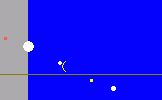 April 17, 6 BC, at dawn L2R: Jup., Moon, Sat., Ven. | 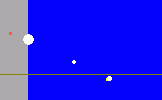 April 24, 6 BC, at dawn conj. of Venus & Saturn | 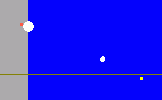 May 8, 6 BC, at dawn conj. of Venus & Jupiter | 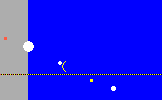 April 17 - May 13, 6 BC, day by day sequence at dawn |
And, Bob continues, when the three kings were in Jerusalem
(which must have been many months later than the first sighting of the star,
given the distance they had to travel), after having spoken to king Herod:
|
"When they had heard the king they went their way; and lo, the star which they had seen in the East went before them, till it came to rest over the place where the child was." (Matt. 2:9) |
Normally the outer planets (Mars, Jupiter, Saturn) move from West to East through the stars because of their proper motion in their orbit around the Sun, which could be seen as "backwards" with respect to the daily motion of the Sun and all other celestial objects, which is of course due to Earth's rotation around its axis. But at some moments the Earth is "taking the inner curve", thereby "overtaking" an outer planet, causing the planet's apparent motion to go in the other direction, forward so to say (in astronomy this is called retrograde motion, actually meaning backwards, but in ancient times it might well have been called forward).
Then "the star went before them" could be an indication of this forward motion, according to Bob Brier.
Jupiter, wich earlier was in conjunction with Venus, was in this "forward motion" from August 23 until December 19, 6 BC.
Then "till it came to rest" would indicate 19 December as the date when the three kings arrived in Bethlehem.
Bethlehem lies to the South-South-West of Jerusalem and at that evening Jupiter stood near the South-South-West
(and what Bob didn't mention: it was accompanied by the Moon (1 day after 1st quarter) and Saturn,
a bit more to the West).
So far about Bob Brier's vision.
There is yet another very remarkable event that occurred on 17th June, 2 BC around 6PM UTC.
It was an extremely close conjunction of Jupiter and Venus, of which you find information here and here. The latter page shows that in South America it even was a true occultation, i.e. Venus actually passed before Jupiter! But this was a once-only event and therefore, to my opinion, a lesser candidate for the star of Bethlehem.
So I'll stick to the triple Jupiter/Saturn conjunctions in 7 BC as most probably being the star of Bethlehem,
as it fits the Biblical description just as good. And I think it was a more remarkable and spectacular series of events
since in this situation there are two planets being very near to each other for several months,
having three consecutive conjunctions.
And this triple conjunction was preceded by the remarkable event on March 25,
which the Christian Church has always seen as the date of Jesus' conception.
The first Jupiter + Saturn conjunction was in the East,
both planets were in "forward" motion during the second conjunction,
and somewhere between the 2nd and 3rd conjunction they both "came to rest".
And at the moment of the third conjunction they stood in the South-South-West shortly after sunset,
above Bethlehem, as seen from the Jerusalem perspective...
Anno Domini
The Anno Domini year number was introduced by Dionysius Exiguus in A.D. 525 in his Liber de Paschate and he calls it: "annus ab incarnatione Domini nostri Jesu Christi", which means "year since the incarnation of our Lord Jesus Christ", so it was intended to start on the day of the conception of Jesus, not his birth. Probably Dionysius made a small computational error, causing Christ to be born a few years before Christ...
|
Intermezzo Sepp Rothwangl, author of the CALENdeRsign website, suggests a theory that Dionysius has intentionally made this error. One of his arguments is the Latin word inchoantes in the sentence where Dionysius introduces the Anno Domini year numbering. He says this is a spelling error in Latin and that it should have been incohantes, meaning beginning. Then inchoantes would be a "secret" hint to a wrong beginning... According to Rothwangl Dionysius has done this in order to fix the event below to the year 2000:
Rothwangl suggests that the year 2000 had to be the year of this event, because it would introduce the age of Aquarius. It could be true, but I think it is mere speculation. I doubt if Dionysius was able to predict this event so accurately, although it could be possible. In ancient times many periodic astronomical cycles were already quite precisely known. And one may indeed doubt if it is a pure coincidence that this rare astronomical event occurred exactly in the year 2000, which is truly felt as a "special" number by many people. And what to think of the following: in roman digits, 2000 is written as MM, the initials of... Did you read the Da Vinci Code? |
When was the crucifixion of Jesus?
The crucifixion of Jesus Christ was on Friday 15 Nisan (on the Hebrew calendar), according to the Catholic Encyclopedia, but the year is not exactly known. The Catholic Encyclopedia gives AD 29 as the most probable year.
Below is a list of possible dates for 15 Nisan = Pesach, the Jewish passover festival (when they celebrate the exodus). On the modern Hebrew calendar, 15 Nisan cannot ever occur on a Friday, because this calendar is purely arithmetic whith some strange looking (at least for a non-Hebrew), but quite accurate rules that never put 15 Nisan on a Friday. However, this computed calender was not introduced until AD 358 or 359, and at the time of the crucifixion it was still based on true observation of the lunar crescent, which means that in those days 15 Nisan could well have been a Friday. On the Hebrew calendar, Nisan is the first month in spring, or better, the lunar month starting at the new moon closest to the beginning of spring.
The date list is based on accurate astronomical computations (which have just been performed on your own pc by the JavaScript code of this webpage). For a year range around the possible dates the vernal equinox (beginning of spring) and the nearest new moon, which I've called vernal new moon, have accurately been determined.
Possible candidates for the 1 Nisan new moon are this vernal new moon as well as the ones immediately before or after it. This is because on the Hebrew calendar approximately every 3 years a leap month must be inserted to keep the calendar synchronised with the seasons. This leap month is added by doubling the month before Nisan, Adar, to Adar 1 and Adar 2. The necessity of this leap month was however not determined by astronomical methods, but by checking when the crops started growing and such sorts of considerations. This can easily mean that this leap month was sometimes added to a wrong year, shifting Nisan to a moon earlier or later.
The moment of true first observation of the new lunar crescent cannot ever be exactly calculated, no matter how sophisticated the method is. Below it has been estimated as follows: if the age of the new moon is over 20 hours at Jerusalem sunset it is presumed to have been visible. It is entirely possible that due to ancient weather conditions the list below is completely wrong. But since absolutely nothing can be said about meteorologic details of 2000 years ago I simply presume it was never fully clouded on the evening of new moon. The "age" columns show the true age of the moon (in hours) at this sunset time, which has been generalised to 18:00 local solar Jerusalem time, or 15:39 UTC. The possible Pesach dates displayed are of course 15 Nisan. Please notice that a minimum moon age of 20 hours for visibility of the lunar crescent is a VERY LOW threshold. In most cases the new moon is well over 24 hours old when first seen, so we should not search only Fridays. A suggested Thursday can be too optimistic, Pesach might have been the Friday therafter.
The Catholic Encyclopedia has at least two pages with info of the date of the crucifixion: Chronology of the Life of Jesus Christ and Biblical Chronology. Especially on the latter page is suggested that it might have been on 14 Nisan instead of the 15th, so we should also search for Pesach on a Saturday, then 14 Nisan was a Friday. It also states it should be between the years AD 26 and 36, but not later than 33.
